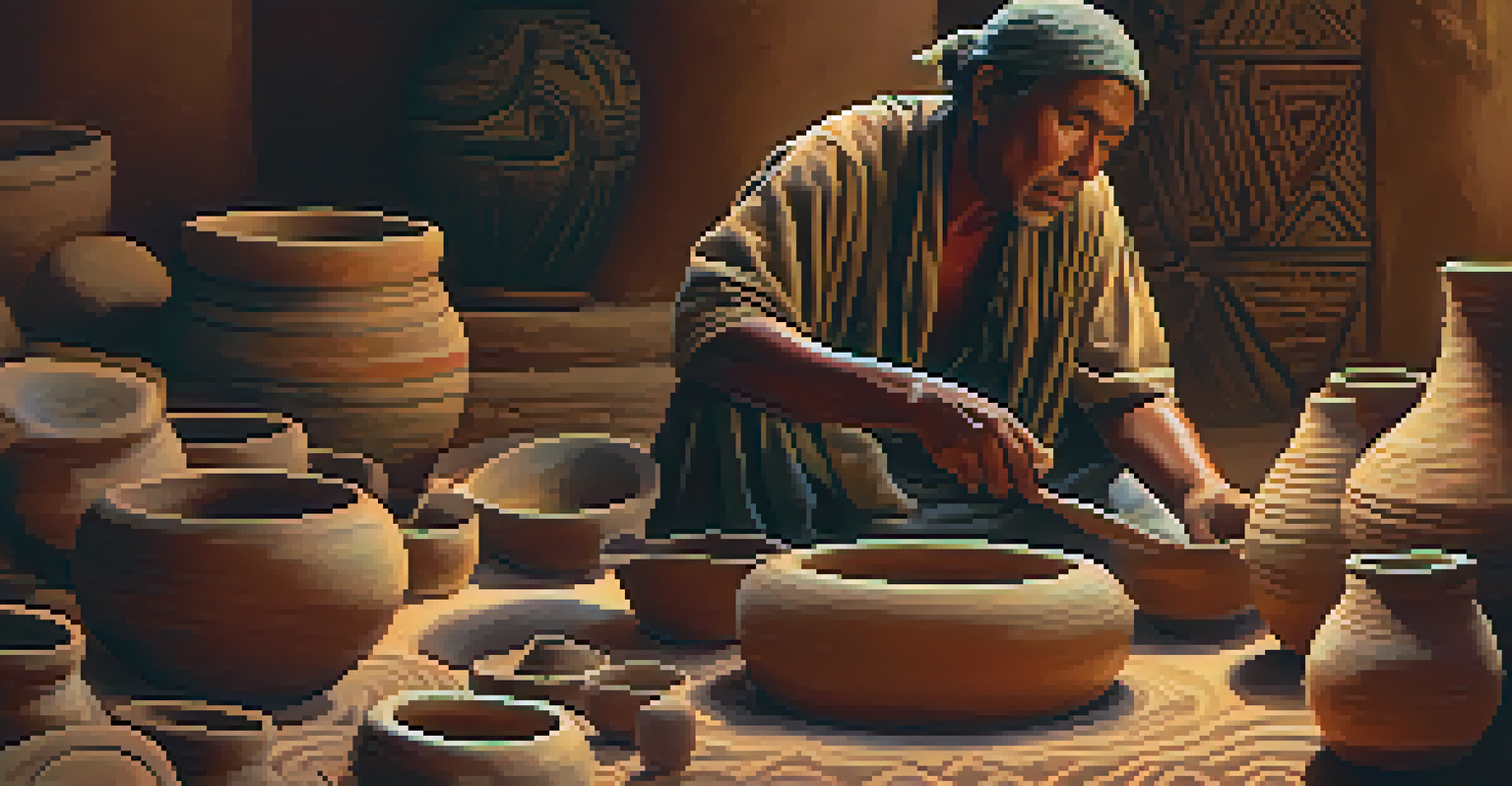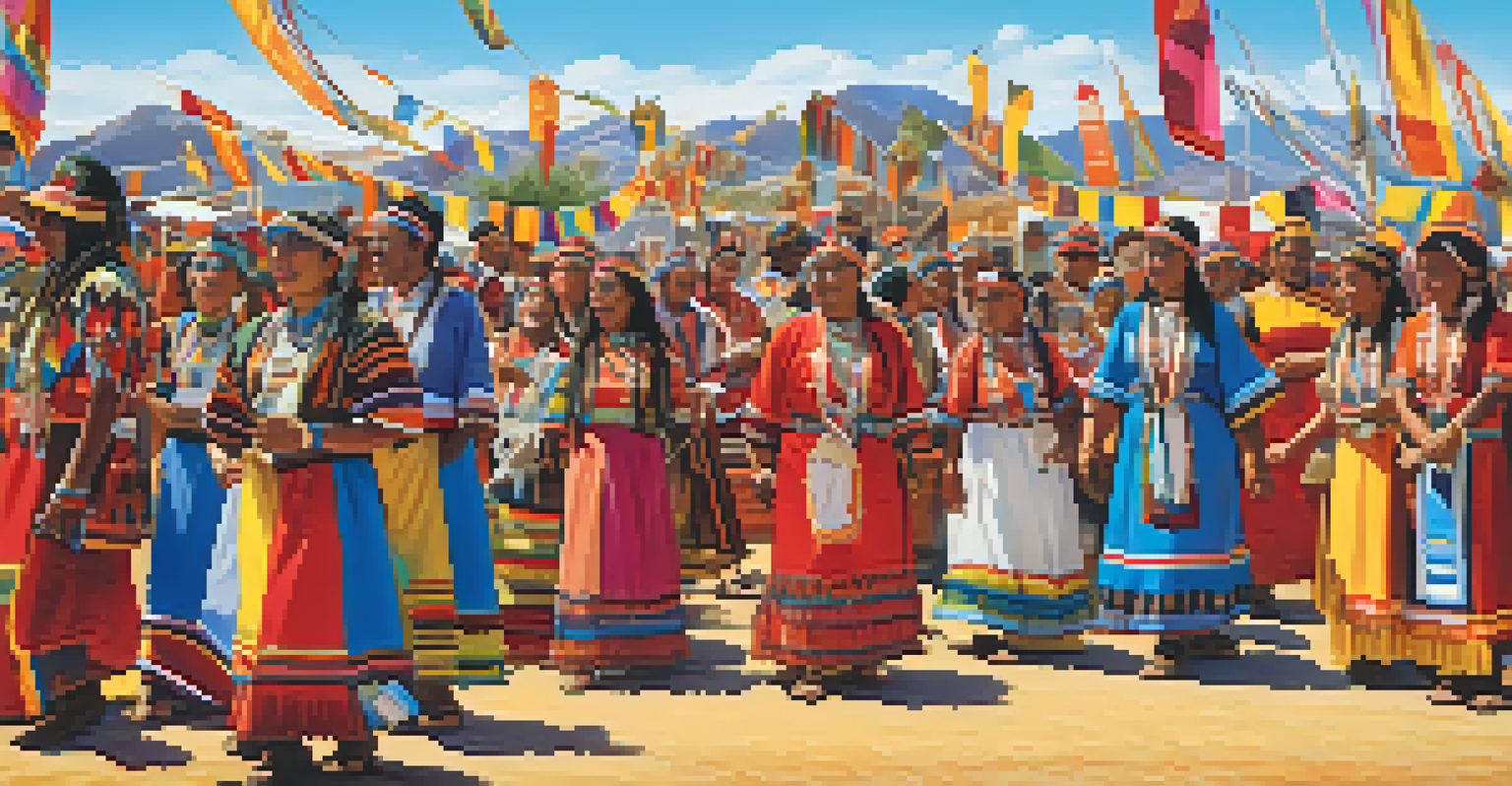Phoenix and the Salt River Valley Native Tribes

An Overview of Phoenix and the Salt River Valley
Phoenix, the capital of Arizona, is nestled in the heart of the Salt River Valley. Known for its vibrant culture and stunning desert landscapes, it's also a region steeped in rich indigenous history. The Salt River Valley has been home to various Native American tribes for thousands of years, each contributing to the area's cultural tapestry.
The land is sacred to those who live upon it. It is part of our very being and identity.
The valley is characterized by its unique geography, which includes the Salt River, a vital water source that has supported agriculture and settlement. This natural resource played a crucial role in the lives of the tribes, making the area an attractive place for habitation. Understanding the history of this region requires recognizing the deep connection between the land and its original inhabitants.
As we delve into the lives of the Native tribes in this area, it’s essential to acknowledge how their traditions and practices have shaped the modern identity of Phoenix. From agricultural innovations to artistic expressions, the legacies of these tribes continue to influence the region today.
The Hohokam Tribe: Pioneers of the Valley
One of the most prominent tribes in the Salt River Valley was the Hohokam, known for their advanced irrigation systems. They thrived from around 300 to 1500 AD, creating extensive canal networks that transformed the arid landscape into fertile farmland. This ingenuity allowed them to cultivate crops such as corn, beans, and squash, which were staples of their diet.

The Hohokam were not just farmers; they were also skilled artisans and traders. Their pottery and jewelry are renowned for their craftsmanship, often featuring intricate designs that reflect their cultural beliefs and practices. The presence of trade routes indicates that they interacted with various tribes, highlighting their role in a broader network of indigenous peoples.
Cultural Heritage of Native Tribes
The Native tribes in the Salt River Valley have a rich cultural heritage shaped by their historical practices and deep connection to the land.
Unfortunately, by the late 15th century, the Hohokam civilization began to decline, leaving behind a legacy that still fascinates historians and archaeologists today. Their advanced agricultural practices and artistic contributions laid the groundwork for future generations in the Salt River Valley.
The Akimel O'odham: Keepers of the River
The Akimel O'odham, or River People, are descendants of the Hohokam and continue to inhabit the region. Their connection to the Salt River remains strong, as they rely on its waters for agriculture and sustenance. The tribe has maintained many of their ancestral traditions while adapting to modern challenges.
Cultural preservation is not just about keeping traditions alive; it's about ensuring that our identity thrives in the face of modern challenges.
Cultural practices among the Akimel O'odham include traditional farming techniques, which emphasize sustainability and respect for the land. They grow crops like cotton and various fruits, which are integral to their way of life and cultural identity. This agricultural heritage is celebrated through community events and festivals.
Moreover, the Akimel O'odham are committed to preserving their language and traditions for future generations. By educating younger members of the tribe about their history and customs, they ensure that their rich culture continues to thrive amidst a rapidly changing world.
The Pee-Posh Tribe: Guardians of Tradition
The Pee-Posh, or Maricopa, are another vital tribe in the Salt River Valley, known for their rich oral traditions and craftsmanship. Historically, they engaged in trade with neighboring tribes, exchanging goods and cultural knowledge, which played a significant role in their societal development. Their strong sense of community is evident in their social structures and governance.
The Pee-Posh have a deep spiritual connection to their land, which is reflected in their customs and beliefs. They celebrate various ceremonies that honor their ancestors and the natural world, emphasizing the importance of maintaining harmony with nature. These practices not only strengthen community bonds but also serve as a reminder of their historical resilience.
Modern Challenges and Resilience
Despite facing challenges such as urban development and climate change, Native tribes are actively working to preserve their cultural identity and traditions.
In recent years, the Pee-Posh have focused on revitalizing their cultural practices, ensuring that younger generations remain connected to their heritage. This commitment to cultural preservation is vital for sustaining their identity and passing down valuable knowledge to the future.
Modern Challenges Faced by Native Tribes
While the Native tribes of Phoenix and the Salt River Valley have rich histories, they also face modern challenges that threaten their cultural identity. Issues such as urban development, land disputes, and environmental changes pose significant threats to their way of life. Many tribes are working tirelessly to address these challenges while preserving their heritage.
One of the significant issues is the loss of traditional lands, which affects their ability to practice cultural traditions and maintain their agricultural practices. As more land is developed for urban use, the connection between the tribes and their ancestral lands becomes increasingly tenuous. This disconnection can lead to a decline in cultural practices and language.
Moreover, climate change is impacting the natural resources that many tribes depend on. Water scarcity and changes in weather patterns threaten their agricultural viability, which is essential for both sustenance and cultural practices. Many tribes are actively seeking solutions, implementing sustainable practices, and advocating for their rights to water and land.
Cultural Revitalization Efforts
In response to modern challenges, Native tribes in the Phoenix area are actively engaging in cultural revitalization efforts. These initiatives aim to preserve and promote their languages, traditions, and arts, ensuring that their rich heritage is not lost. Community programs often include workshops, storytelling sessions, and cultural festivals that celebrate their identity.
Education plays a crucial role in these revitalization efforts. Many tribes are incorporating traditional knowledge into school curricula, allowing younger generations to learn about their history and cultural practices. This educational approach fosters a sense of pride and belonging among tribal youth, helping them connect with their roots.
Revitalization and Community Engagement
Cultural revitalization efforts and community engagement initiatives are essential for ensuring that traditional knowledge and practices are passed down to future generations.
Additionally, the tribes are utilizing technology and social media to reach wider audiences. By sharing their stories and cultural practices online, they can raise awareness and appreciation for their heritage. This modern approach not only engages younger members but also invites others to learn about and respect their culture.
Community Engagement and Collaboration
Community engagement and collaboration are vital for the Native tribes in Phoenix as they work towards preserving their culture. Partnerships with local organizations, educational institutions, and government agencies help amplify their voices and advocate for their rights. These collaborations often result in programs that benefit both tribal members and the wider community.
Events such as cultural festivals, art exhibitions, and educational workshops not only showcase Native traditions but also promote understanding and respect among diverse populations. By inviting others to participate, tribes foster a sense of inclusivity and appreciation for their heritage. This engagement helps break down stereotypes and builds bridges between cultures.

Furthermore, the tribes are increasingly involved in discussions about environmental sustainability and land use. By sharing their traditional ecological knowledge, they contribute valuable insights into sustainable practices that benefit the entire region. Through collaboration, they demonstrate that cultural preservation and environmental stewardship go hand in hand.
Looking to the Future: A Bright Path Ahead
As we look to the future, the Native tribes of Phoenix and the Salt River Valley are poised to continue their journey of cultural preservation and revitalization. Their resilience in the face of modern challenges is a testament to their strong connection to their heritage. With ongoing efforts to educate younger generations and engage the community, their rich history will remain vibrant.
The emphasis on sustainable practices and environmental stewardship demonstrates their commitment to not only preserving their culture but also protecting the land that sustains them. As they adapt to changing circumstances, these tribes are finding innovative ways to blend tradition with modernity, ensuring their relevance in a rapidly evolving world.
Ultimately, the future looks promising for the Native tribes in this region. By fostering a sense of pride and belonging, they inspire a new generation to carry on their legacies. As they navigate the complexities of contemporary society, their voices will undoubtedly continue to resonate, enriching the cultural landscape of Phoenix and beyond.